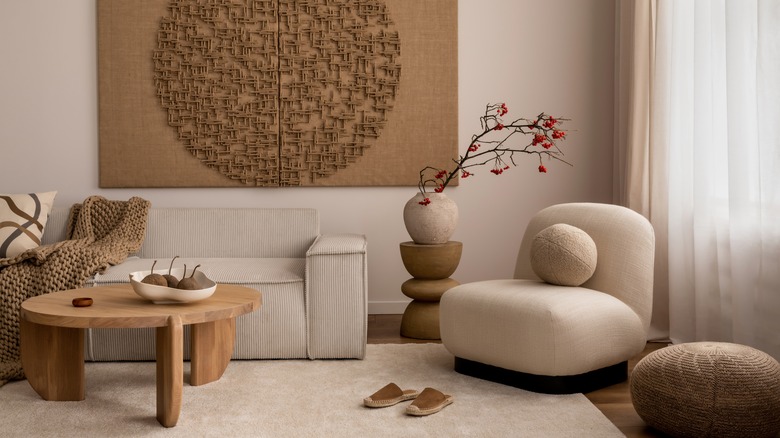Not Sure If A Coffee Table Will Clutter Your Room? Follow This Advice To Find Out
It might seem that style is the most important consideration when selecting a new coffee table — after all, next to the sofa, it's the centerpiece of the living room layout. The material, finish, and shape is crucial to nailing the space's design aesthetic; and a room without one feels unfinished.
Yet, a coffee table, aka as a cocktail table, need not be predictable. An upholstered ottoman, for example, provides softness and seating and is a child-friendly alternative. On the other hand, small bunching tables can be separated and spread around the room — a great coffee-table option for people who frequently entertain. A dining-height table, meanwhile, is a pleasant complement to a high-backed sofa or tall ceiling, and the perfect surface for those who like to eat and lounge at the same time. From traditional to modern, customary to unconventional, and transparent acrylic to solid stone, there is a stunning variety of available cocktail tables.
There are, however, overriding factors less obvious and less fun than how a coffee table looks. One, it should be a quality piece able to withstand daily use, and it should be sturdy, flat, and amply sized to function as needed. Still, ultimately, designers prioritize correct scale and positioning when it comes to the coffee table. As interior designer Caitlin Flemming explained in Homes & Gardens, "You always want to be sure you have plenty of room between the coffee table and the sofa and chairs in the room. Otherwise, it will not only make the room look small, but will also make it feel small."
Give it some space
No matter the style or substance of a coffee table, its proportion has a predominant effect on the read of the space. "It's all about the scale of the room and the furniture already in place," notes interior designer Jennifer Muirhead. As she told Homes & Gardens, "A coffee table should be large enough that everyone seated around it can reach it comfortably, without having to stand up and walk over to it. That is what makes a room look 'wrong'." Conversely, no one should be bumping knees against it either. "A too-large coffee table will make a space feel cluttered and small," she elaborated, echoing the previous advice.
So, what's the formula for achieving that design sweet spot? Simply allow 16 to 18 inches of free space around the perimeter of the coffee table. Between the table and the upholstery, regardless of the room's dimensions, orientation, or style, there should be near 1½ feet of airy nothingness. This ensures flow, ease, and an inviting vibe.
Take accurate measurements of the room and all relevant furniture before you go shopping for your next coffee table, and if you see a piece that makes your heart skip a beat, size it up ruthlessly. Insisting on the above parameter puts the focus on comfort and utility, but in the end, it drastically impacts the appearance. Once the foundation is right, less imperative factors, like aesthetics, can be considered.

